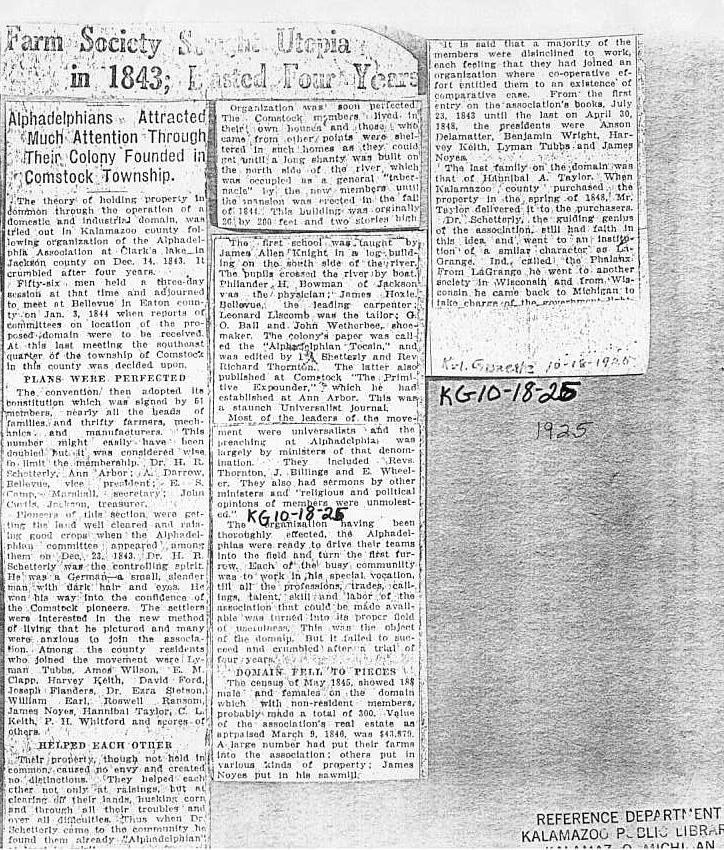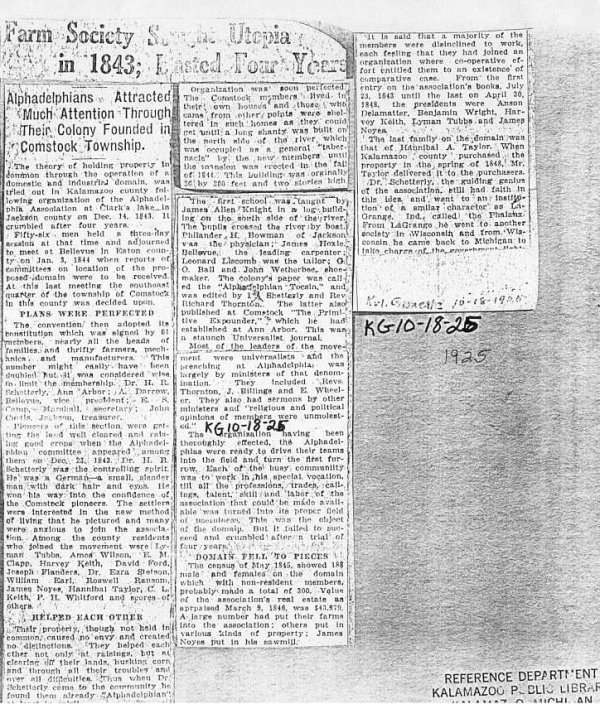Article source, Nancy Benton. Transcribed by me.
* * * * *
Farm Society Sought Utopia in 1844; Lasted Four Years
Alphadelphians Attracted Much Attention Through Their Colony Founded in Comstock Township
Kalamazoo Gazette, October 18 1925
The theory of holding property in common through the operation of a domestic and industrial domain, was tried out in Kalamazoo county following organization of the Alphadelphia Association at Clark’s lake in Jackson county on Dec. 14, 1843. It crumbled after four years.
Fifty-six men held a three-day session at that time and adjourned to meet at Bellevue in Eaton county on Jan. 3, 1844 when reports of committees on location of the proposed domain were to be received. At this last meeting the southeast quarter of the township of Comstock in this county was decided upon.
PLANS WERE PERFECTED
The convention then adopted its constitution which was signed by 51 members, nearly all the heads of families, and thrifty farmers, mechanics, and manufacturers. This number might easily have doubled but it was considered wise to limit the membership. Dr. H. R. Schetterly, Ann Arbor; A. Darrow, Bellevue, vice president; E. S. Camp, Marshall, secretary; John Curtis, Jackson, treasurer.
Pioneers of this section were getting the land well cleared and raining good crops when the Alphadelphian committee appeared among them on Dec. 23, 1843. Dr. H. R. Schetterly was the controlling spirit. He was a German–a small, slender man with dark hair and eyes. He won his way into the confidence of the Comstock pioneers. The settlers were interested in the new method of living that he pictured and many were anxious to join the association. Among the county residents who joined the movement were Lyman Tubbs, Amos Wilson, E. M. Clapp, Harvey Keith, David Ford, Joseph Flanders, Dr. Ezra Stetson, William Earl, Roswell Ransom, James Noyes, Hannibal Taylor, C. L. Keith, P. H. Whitford and scores of others.
HELPED EACH OTHER
Their property, though not held in common, caused no envy and created no distinctions. They helped each other not only at raisings, but at clearing off their lands, husking corn and through all their troubles and over all difficulties. Thus when Dr. Schetterly came to the community he found them already “Alphadelphian” (last line article appears to be snipped).
Organization was soon perfected. The Comstock members lived in their own houses and those who came from other points were sheltered in such homes as they could get until a long shanty was built on the north side of the river which was occupied as a general “tabernacle” by the new members until the mansion was erected in the fall of 1844. This building was originally 26 by 200 feet and two stories high.
The first school was taught by James Allen Knight in a log building on the south side of the river. The pupils crossed the river by boat. Philander H. Bowman of Jackson was the physician; James Hoxle, Bellevue, the leading carpenter; Leonard Liscomb was the tailor; G. O. Ball and John Wetherbee, shoemaker. The colony’s paper was called the “Alphadelphian Tocsin,” and was edited by H. R. Shetterly and Rev. Richard Thornton. The latter also published at Comstock “The Primitive Expounder,” which he had established at Ann Arbor. This was a staunch Universalist journal.
Most of the leaders of the movement were universalists and the preaching at Alphadelphia was largely by ministers of that denomination. They included Revs. Thornton, J. Billings and E. Wheeler. They also had sermons by other ministers and ‘relgious and political opinions of members were unmolested.”
The organization having been thoroughly effected, the Alphadelphians were ready to drive their teams into the field and turn the first furrow. Each of the busy community was to work his special vocation, till all the professions, trades, callings, talent, skill and labor of the association that could be made available was turned into its proper field of usefulness. This was the object of the domain. But it failed to succeed and crumbled after a trial of four years.
DOMAIN FELL TO PIECES
The census of May 1845, showed 188 male and females on the domain which with non-resident members, probably made a total of 300. Value of the association’s real estate as appraised March 9, 1846 was $43,879. A large number had put their farms into the association: others put in various kinds of property; James Noyes put in his sawmill.
It is said that a majority of the members were disinclined to work, each feeling that they had joined an organization where co-operative effort entitled them to an existence of comparative ease. From the first entry on the association’s books, July 23, 1843 until the last on April 30, 1848, the presidents were Anson Delamatter, Benjamin Wright, Harvey Keith, Lyman Tubbs and James Noyes.
The last family on the domain was that of Hannibal A. Taylor. When Kalamazoo county purchased the property in the spring of 1848, Mr. Taylor delivered it to the purchasers.
Dr. Schetterly, the guiding genius of the association, still had faith in this idea and went to an institution of a similar character in Lagrange. Ind. called the Phalanx. From LaGrange he went to another society in Wisconsin and from Wisconsin he came back to Michigan to take charge of the government (… rest of article snipped).


Leave a Reply